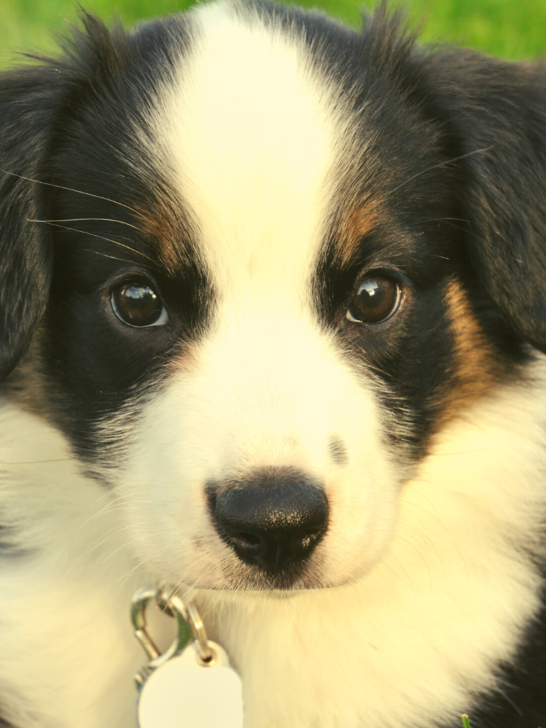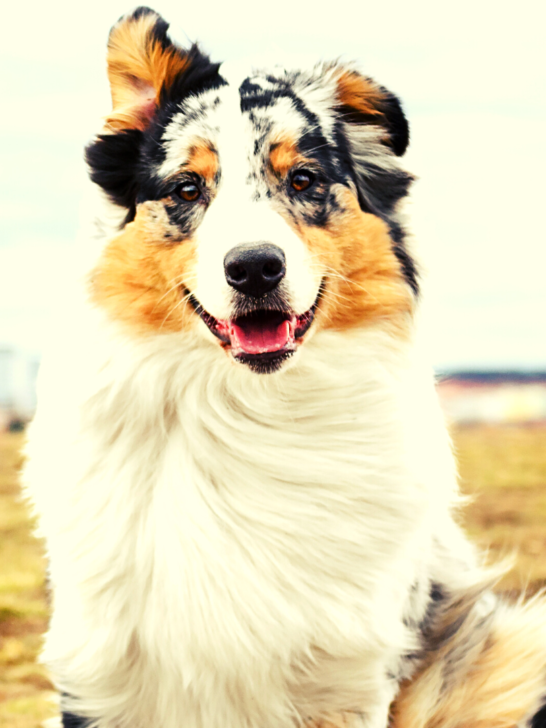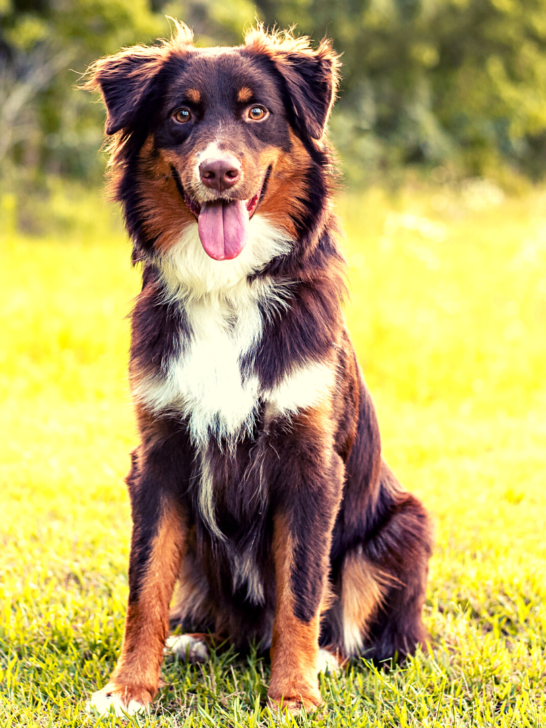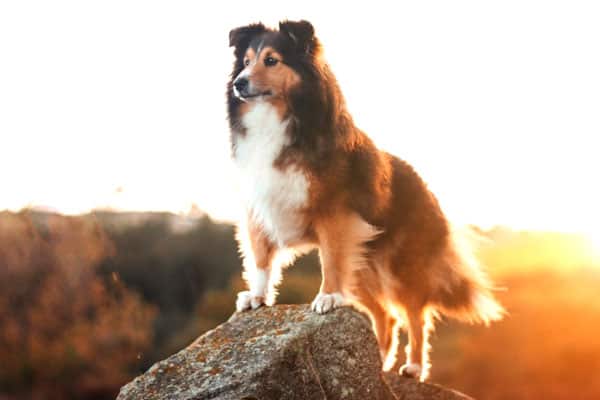Papillon Australian Shepherd Mix: The Intelligent & Playful Dog with a Heart as Big as Its Brains
The Papillon and Australian Shepherd (Austi-Pap) mix is a relatively new hybrid that’s gradually gaining popularity around the world.
As such, not much information is readily available about this wonderful cross-breed, which is why we thought it’d be a brilliant topic to write about.
There are three types of purebred Australian Shepherd: Standard, Toy, and Miniature. It doesn’t matter which of these dogs breed with the Papillon, the pup will always be considered an Austi-Pap.
Designer dogs have acquired something of a bad name over recent years, but the truth is that even though the term has negative materialistic connotations, cross-breeding is the correct thing to do, morally speaking.
We’re all aware that pure breeds suffer from countless health issues that are both debilitating for them and expensive for owners. Mutts, on the other hand, with their mixed genes, are far more likely to live long, happy, healthy lives.
In light of this, prospective dog owners can enjoy exotic crossbreeds such as the Austi-Pap with a clear conscience.
The genetic diversity vastly increases the living standards of the pup, but that’s by no means the only reason to invite one of these bundles of joy and fluff into your family unit.
As you’re about to discover, the Austi-Pap makes for an amazing all-fours friend for life.
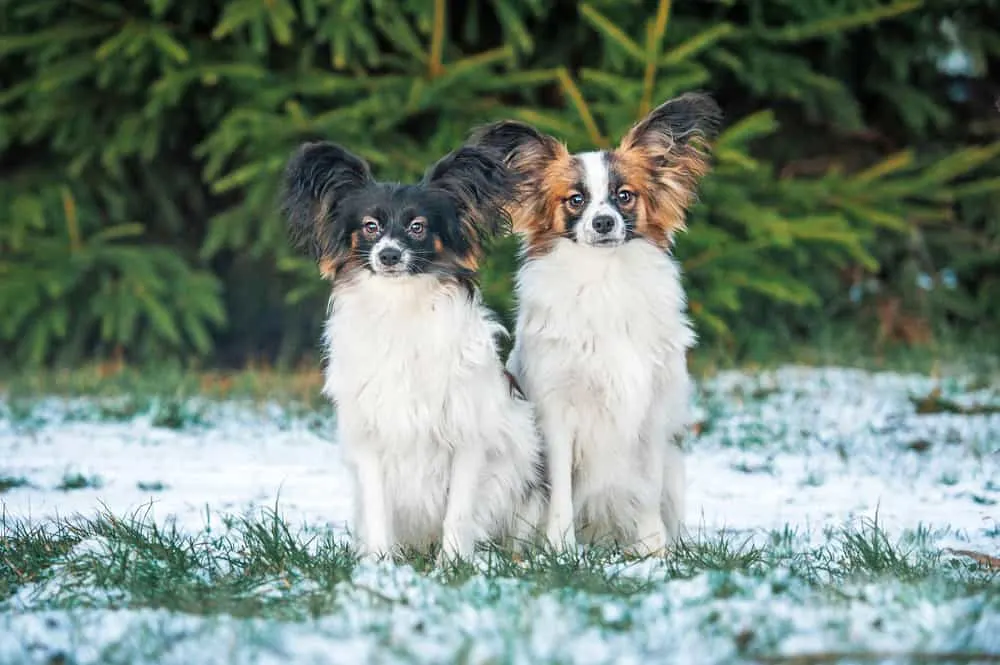
Australian Shepherds and Papillons – A History of Hounds
Being that this adorable hybrid hound is fairly new on the scene, there’s not much of a shared history to look into, so let’s explore the poochie pasts of its purebred parents to explore what might be in store for them.
Australian Shepherd – A Brief History
You’d be forgiven for thinking that the Australian Shepherd hails from the sunny lands of Australia, but believe it or not, you can trace their origins to the Pyrenees mountains of Southwest Europe.
Its mountain-dwelling ancestor is known as the Berger de Pyrenees.
Eventually finding use as herding dogs, they developed a strong work ethic and goal-oriented outlook on life.
Early iterations of this playful yet hardworking breed ended up in America, finding particular popularity as herders during the gold rush, when more sheep were being tended in order to feed and clothe the influx of miners.
However, they weren’t just herding and ranch dogs; their intelligence and athleticism opened up a myriad of possibilities for them, including roles in service and therapy. Some were even used as trick dogs in the circus!
Fast forward to the present day, and the Australian Shepherd is the 17th most popular dog in the USA.
The same skills imparted by the genetic code of their ancestry ensure their relevance in the modern age. They’re suitable for humdrum family life, sharing workloads, and loving as hard as they possibly can.
Popular as they might be now, the Australian Shepherd was already well accustomed to attention. In fact, this is their second time in the limelight, as in the 1950s, they gained popularity with the public after their appearance in numerous films and rodeos.
Papillon – A Brief History
Unlike the Aussie Shepherd, we can draw a definitive conclusion from Papillon’s name. It sounds French, and it is French.
Named for their distinctive wing-like ears, papillon in French means butterfly — beautiful, right? Poetically, Papillons with floppy ears rather than upright ears were known as Phalene, the French for moth, as the moth holds its wings close to its body.
Genetically derived from the Dwarf Spaniel, the Papillon is one of the oldest dog breeds in the world, thought to have been earning our pats and scratches since the 13th century.
It wasn’t long before this highly trainable and happy breed worked its way across Spain and Italy, where it was documented in many a classic painting.
Owned by King Louis XIV of France and Marie Antoinette, they were thought of as fairly regal woofers, but they found equal use as ratters, earning their keep by killing and chasing away vermin from the household.
It wasn’t until the late 19th century that Americans first got the opportunity to stroke those fringed, fluffy ears.
They were first recognized by the American Kennel Club (AKC) in 1915.
These days, they’re considered a top-billing toy breed alongside the toy poodle. They’re loved for their elegance and light-footed grace, and they’re championed by trainers for their intelligence.
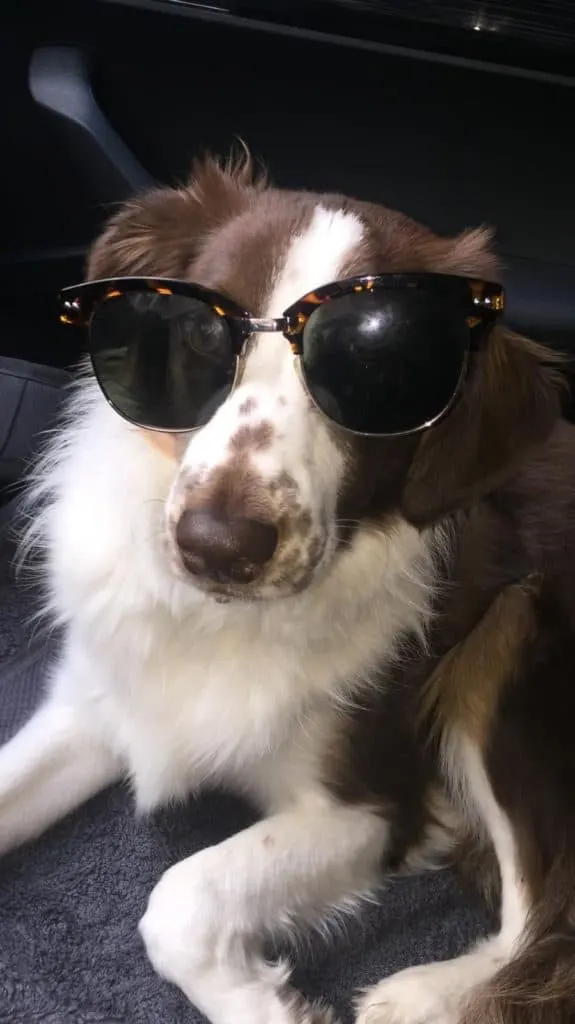
Austi-Pap – A Very Brief (Non) History
It’s unknown who was responsible for breeding the first-ever Austi-Pap or when and where it happened, so in all honesty, there’s not much to tell.
As I’ve already mentioned, this is a relatively new crossbreed, so the stories are yet to be lived, and the histories yet to be written.
By choosing an Austi-Pap as your canine companion, you could become a part of this amazing crossbreed’s nascent narrative.
The Mood of the Mix – Austi-Pap Temperament
Although every dog has its own distinct personality, it’s essential you look into the general character traits of a dog breed before inviting them into your home.
Some will be far more suited than others to your lifestyle and environment, so let’s take a look and see if the Papillon Australian Shepherd mix is a good match for you.
Once again, we’re going to have to break this marvelous mix of dogs into their discrete parts in order to learn more about them.
Australian Shepherd – Temperament and Personality
The Australian Shepherd is famously independent, but that’s not to say they aren’t loving. On the contrary, they have some of the biggest doggy hearts in the world.
They may enjoy some alone time every now and again, but Australian Shepherds are incredibly affectionate with family members of all ages, so they’re perfectly safe to have around your children.
As they’re very protective of their pack, they can be a little untrusting of strangers, but they won’t express this through violence, just the odd bark and suspicious side-eye.
However, when it comes to stranger dogs or other dogs in the household, they’re almost always completely happy. Australian Shepherds just want to have fun and enjoy companionship with their own species.
One of the most intelligent breeds in the world, they’re highly trainable, but also incredibly sensitive, so developing routines and providing a sense of security is essential.
A strong prey drive and an energetic disposition does mean they can be a handful at times, but as long as they get the exercise they need, they’re capable of calm. That said, they love to play between walkies too.
They’re perfectly happy in hot and cold weather, which is part of the reason for their global proliferation.
Papillon – Temperament and Personality
Much like the Australian Shepherd, the Papillon is an incredibly intelligent pup. They’re alert and affectionate towards family and strangers alike. They’re not quite as happy around children as the Aussie Shepherd, but they don’t mind them.
Another thing they have in common with the Australian Shepherd is boundless energy, and as their ancestors were ratters, they have a strong prey drive. That means keeping them around other animals such as cats or rabbits probably isn’t a good idea.
On the other hand, they love being in the company of other dogs, so if you’ve got a few fluffers already, they’ll slot right into the pack.
They also adapt well to apartment living, which makes them good city-dwelling doggos, but you absolutely must take them out for plenty of exercises.
Less sensitive than Aussie Shepherds, they can handle the lifestyle change here and there, but like all dogs, they enjoy routine.
What they dislike with a passion is the cold and being alone, so frigid climates and busy owners get a big NO from the Papillon. Otherwise, they’re very happy dogs looking for lots of love and fun.
Austi-Pap – Temperament and Personality
Combining the traits of these two wonderful breeds amounts to a loyal, utterly loving pooch with brains for days. They relish an opportunity to hang with other dogs, and they’re great around humans of all ages.
They’re also fairly happy to be around strangers, but they will always be a little protective of family, which ultimately, is what you want out of your fluffy child.
Inheriting the work ethic of their ancestors, Austi-Paps are also one of the most energetic dogs on the planet, so be prepared to spend some time in the great outdoors playing fetch for hours.
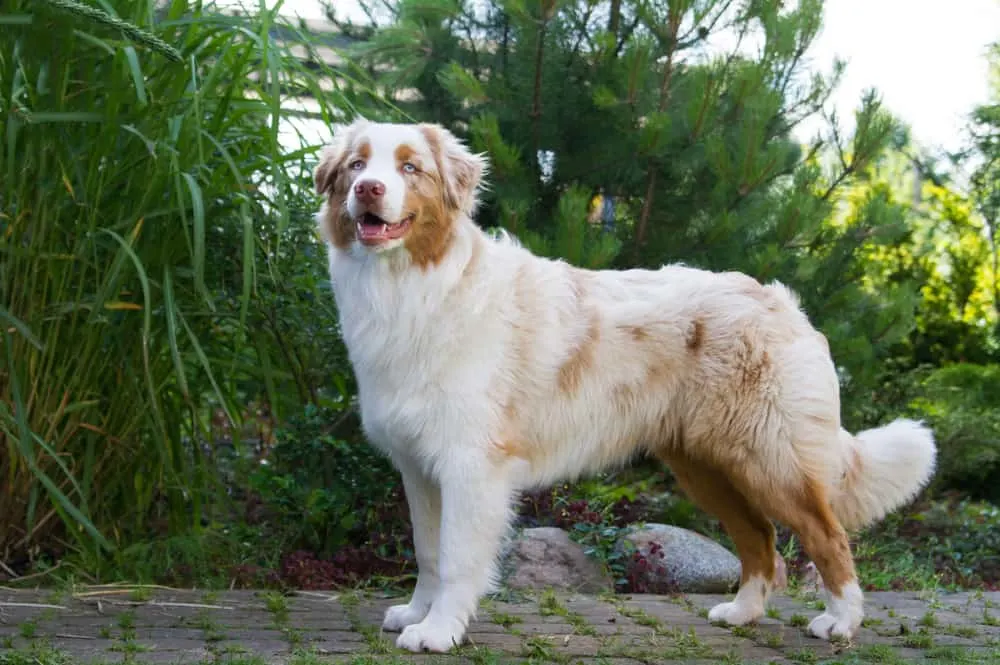
The Shape of Pups to Come – Austi-Pap Size, Height, and Weight
Now let’s take a look at some of the physicalities of this beautiful woofer brew.
Australian Shepherd – Size, Height, and Weight
Australian Shepherds are classed as medium-sized dogs, which makes their infinite energy far easier to handle. They typically weigh between 40-65lbs, and measure 18-23 inches tall from paw to shoulder.
Papillon – Size, Height, and Weight
Papillons are toy dogs, which is a small class of canines. They can weigh anything from just over 7lbs to just under 10lbs, and they tend to measure between 7 and 11 inches tall.
Austi-Pap – Size, Height, and Weight
Austi-Paps usually rest on the border between small and medium-sized dogs, but as there are toy and miniature variants of the Australian Shepherd, Austi-Paps can also end up remarkably tiny.
Toy Austi-Paps are known to weigh roughly 12lbs and can grow to around 14 inches tall. Standard Austi-Paps tend to grow a couple of inches taller and weigh upward of 20lbs. It all depends on the stature of their poochie parents.
Hitting the Doggo Gym – Austi-Pap Training and Exercise Requirements
You’ll have noticed one of the constants between Australian Shepherds and Papillons is their tirelessness, so you can bet your bottom dollar that the Austi-Pap is going to run you ragged.
It’s for this reason I wouldn’t recommend them for senior pup parents. Unless you enjoy the odd marathon in your golden years, you won’t be able to keep up with their exercise regime.
Austi-Pap owners have to center their day, and really, their lives around this fluffy ball of pure energy.
Training, on the other hand, is a total breeze. Austi-Paps absolutely love purpose, and they’re ridiculously smart, so it’s not uncommon for them to master numerous tricks and commands in a single day.

Hair Today, Gone Tomorrow – Austi-Pap Shedding and Grooming
You can predict the grooming shedding style of an Austi-Pap fairly accurately simply by comparing the coats of the Aussie Shepherd and the Papillon
Australian Shepherd – Shedding and Grooming
The Australian Shepherd has the luscious double coat typical of medium and large working dogs, which means year-round shedding and plenty of grooming with tools such as this slicker brush.
But every floof has a silver lining: Australian Shepherds may lose fur year-round, but they’re not heavy shedders.
Papillon – Shedding and Grooming
Papillons only have a topcoat, which is part of the reason they dislike cold weather. They’re also fairly light shedders — hurray! But as they have quite long fur (especially around the ears), they do need grooming a few times a week.
Austi-Pap – Shedding and Grooming
Depending on the dominant breed in the mix, you could be looking at a pretty hectic grooming schedule with an Austi-Pap. We’re talking daily, folks.
The good news is that they’re very moderate shedders, so don’t worry about forking out for that expensive vacuum just yet.
Austi-Pap Health Issues and Longevity
We don’t have access to health records of Austi-Paps because, well…the records haven’t been written yet, so let’s put the parents under the microscope one last time.
Australian Shepherd – Health Issues and Longevity
As a pure breed, Australian Shepherds are more susceptible to health issues, namely…
- Hip Dysplasia
- Elbow Dysplasia
…and their average life expectancy falls between 12 and 15 years.
Papillon – Health Issues and Longevity
As the older breed, it stands to reason that the Papillon would be prone to the most illnesses, including…
- Luxating Patellas
- Von Willebrand’s Disease
- Cataracts
…and they have a life expectancy of 13 to 15 years.
Austi-Pap – Health Issues and Longevity
We can gather from this analysis that there is a fairly wide illness spectrum between these breeds, with problems affecting joints, eyes, and bleeding.
The good news here is that the parent breeds don’t share any genetic ailments, reducing the likelihood that your Austi-Pap will experience any of them.
That said, there’s always a chance of genetic infirmity, especially if a dog is the first cross-breed in the line.
To avoid the utterly heartbreaking event of a poorly pooch, ask a breeder to show you pre-screening tests clearing the prospective parents of all these common conditions.
Is the Papillon Australian Shepherd Mix the Right Dog for You?
In many ways, the Austi-Pap is the perfect dog. They’re affectionate, happy, intelligent, and they’re nice and small too. The only issue is their boundless energy.
To welcome an Austi-Pap into your life, you need to be passionate about the great outdoors and exercise. If that sounds good to you, they’ll be the ideal fluffy friend for you.
















